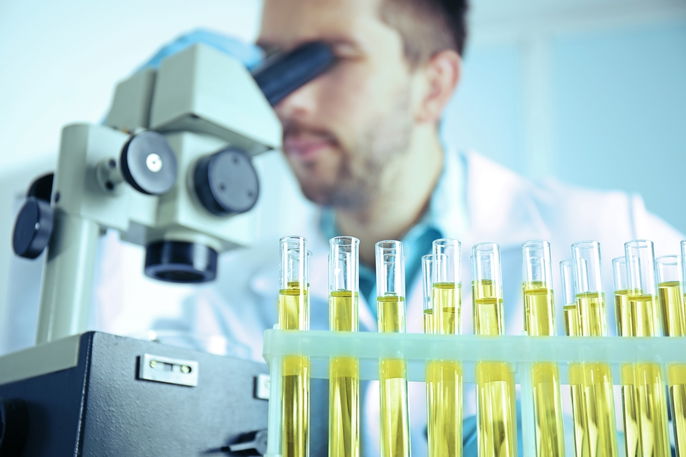What is it:
Bacteria in urine may occur due to incorrect collection of urine that results in contamination of the specimen. A UTI may also cause bacteria in the urine, as well as other abnormalities in the urine test (like the presence of leukocytes, epithelial cells, and in some cases, red blood cells).
Bacteria in the urine can be confirmed with a urine routine and microscopy (urine R&M) test. When the urine contains bacteria, this finding should be compared to other results, like leukocytes, pH and urine color, to reach a final diagnosis.
Depending on the diagnosis, the family doctor, urologist or gynecologist may order further testing or initiate treatment as appropriate.

What the results mean
Bacteria in the urine is identified through a urine R&M test, in which the lab looks at a urine specimen through a microscope. Through this examination, it is possible to observe whether bacteria are present in the urine or not. Bacteria results are reported as:
- No bacteria noted, when bacteria is not observed in the urine
- Scant bacteria or +, when 1 to 10 bacteria are seen in 10 visual fields
- Some bacteria or ++, when 4 to 50 bacteria are observed
- Many bacteria or +++ , when up to 100 bacteria in 10 visual fields are visualized
- Numerous bacteria or +++++, when over 100 bacteria are seen in the observed visual fields
If bacteria is noted in the urine, the urine R&M test should be assessed as a whole by the ordering doctor. He or she should also consider other presenting symptoms to reach a diagnosis and initiate treatment. Generally, scant or some bacteria is not usually of clinical concern, as the urinary tract naturally contains bacteria that does not require treatment.
Usually, if bacteria is confirmed in the urine, a urine culture test is also ordered (especially if the patient presents with symptoms). A urine culture determines the species of bacteria and the the quantity of colonies it has formed. This test also reports the antibiotic resistance and sensitivity profile so that the most appropriate antibiotic can be prescribed for treatment.
Common causes
The main causes of bacteria in the urine are:
1. Specimen contamination
Specimen contamination is one of the most frequent causes of bacteria in the urine. Contamination can particularly be suspected when there are many epithelial cells and mucus in the urine, but no leukocytes. Contamination occurs at the time of collection, when the genital area is not properly cleansed before catching the urine, or when the patient does not discard the first stream of urine first. In these cases, the bacteria in the urine is natural bacteria found in the urinary tract, and does not pose as a health risk.
What to do: If there are not other abnormalities seen in the urine test, this finding may not be of clinical concern. However, the doctor may opt to order a new specimen for testing. It is important to properly cleanse the genital area before collection (with a baby wipe or wet toilet paper, and ensuring to pat the area dry after cleansing. You should also be sure to urinate first into the toilet, and then to collect the following urine. Specimens should be properly handled and stored at appropriate temperatures until submitted to the lab.
2. UTI
If the specimen has not been contaminated, and many or numerous bacteria are noted in the urine, it may be a sign of a UTI. In addition to bacteria, there may also be many epithelial cells and leukocytes in the urine, which will depend on the microorganism causing infection and the amount present.
To confirm a UTI, the doctor will assess the presenting symptoms and additionally order a urine culture. This test will identify the type of bacteria causing infection and how much is present in the urine.
What to do: Antibiotics are only indicated to treat UTIs when the patient presents with symptoms like burning or pain with urination, bloody urine or bladder heaviness. The doctor can select an antibiotic based on the urine culture’s resistance and sensitivity profile.
If the patient does not have any symptoms, the doctor may opt to not prescribe any antibiotics, as prescribing this medication may induce antibiotic resistance, which can make treatment in the future more complicated.
3. Tuberculosis
Although this is rare, systemic tuberculosis can lead to bacteria in the urine. To confirm or rule it out, the doctor may order urine test that specifically looks for Mycobacterium tuberculosis, which is the bacteria that causes tuberculosis.
Usually, a Mycobacterium tuberculosis urine test is ordered to monitor for response to tuberculosis treatment. Tuberculosis is best diagnosed through a sputum test or a TB skin test.
What to do: If bacteria is found in the urine and the patient is diagnosed with tuberculosis, the doctor should evaluate whether the current treatment plan can be optimized, or if the bacteria became resistant to the prescribed medication and an alternative is required. Treatment for tuberculosis is done with antibiotics, and should continue even after symptoms have resolved to ensure complete eradication of all bacteria.






























